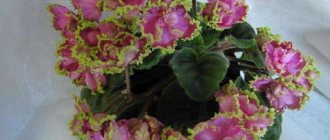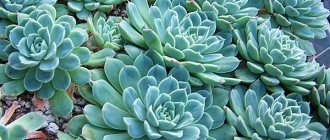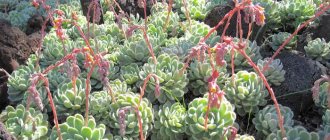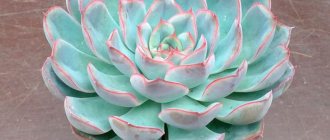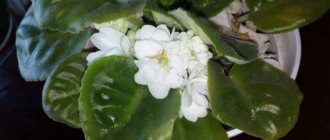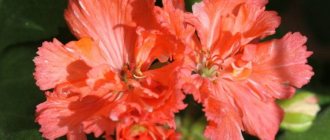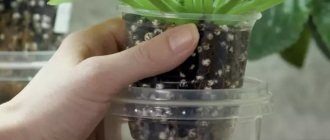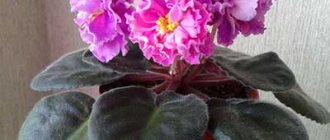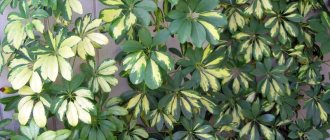International name:
Synonyms:
Characteristics:
| Complexity: |
| Development cycle: |
| Light mode: |
| Watering mode: |
| Temperature: |
| The soil: |
| Key Feature: |
Foliage color
Bud color
Dimensions Flower sizes
Taxonomy:
| Domain: |
| Kingdom: |
| Department: |
| Class: |
| Order: |
| Family: |
| Genus: |
There are quite a few attractive species of Echeveria. But if you are looking for elegance, Echeveria Perle von Nurnberg is worth a look.
The spoon-shaped leaves of this succulent overlap each other to create a perfect rosette. However, the highlight of the Pearl is its color. The plant's coloration is a spectrum of blue-gray and pink with a hint of purple.
Although Echeverias are native to Mexico, this hybrid is native to Germany. This is truly the perfect succulent for beginning gardeners. It is easy to care for and propagate.
Description of plants of the genus Echeveria
Succulents of the genus Echeveria were given their name by the French botanist Augustin Piram de Candolle in 1828. The venerable botanist was on an expedition to Central America in the company of the Mexican botanical artist Atanasio Echeverría and Godoy. The Frenchman was so impressed by Athanasio's artistic skill that he named one of the documented plant families after the artist. Thus, one of the most famous and widespread genera of succulents was named Echeveria.
Echeverias are considered one of the most beautiful succulents. They form attractive rosettes of succulent leaves and often resemble roses, water lilies or tousled lettuce. These are fairly small houseplants, but still very robust and easy to care for. You can forget to water them for a month without them wilting. Plants prefer desert conditions.
Photo of Echeveria in the botanical garden
The leaves come in a variety of colors from simpler greens to some really showy colors. As a rule, the leaves form a rosette that remains almost unchanged throughout life. Forming a rosette allows for maximum exposure to light sources, allowing plants to effectively capture and direct water down to the roots.
The Echeveria succulent plant grows well in both containers and garden beds. The variety and color of Echeveria plants provide wonderful tone and texture for mixed flower beds and containers. The leaves are fleshy and have a waxy cuticle on the outside; touching them can damage the skin of the leaf and leave marks. Often the leaves are colored. Echeveria grows slowly and usually does not exceed 30 cm in height or width.
Echeveria blossom
"Stone Rose" blooms in spring or summer. A long vertical or lateral peduncle becomes the point where lateral-type inflorescences consisting of small flowers appear. The shade of the buds is different. May be brown, red, orange-red or yellow. The petals are quite juicy. Based on how bright the lighting is, the color saturation of the flowers itself also changes. Those that form in the shade have yellowish hues, while those that form under ultraviolet rays have reddish colors.
Features of plant flowering
Ficus microcarpa - care and propagation at home
Not all types and hybrids of succulents bloom; some of them require special conditions.
Important! Small echeverias can be combined in mixes when constructing compositions.
Echeveria blooms most often in the spring and summer months and lasts from 2 to 4 weeks.
Most varieties go dormant in winter. This time requires good lighting and a temperature range of 8 to 15 degrees. Watering is reduced to once a month.
A long lateral or vertical peduncle emerges from the rosette; small flowers collected in inflorescences are located on it.
The color of the petals directly depends on the light level. Insufficient light results in yellow flowers, and bright light results in orange or reddish flowers. After flowering ends, babies form on the peduncle.
Echeveria succulent: how to care at home
“Stone Rose” perfectly withstands both increases and decreases in air temperature; it is also not afraid of ultraviolet radiation or the dry microclimate in the room. That is why the best option for planting would be a window facing south.
During the warm season, these succulent crops feel great both at home and outdoors. In winter, you will need to find a suitable place with a temperature of no more than +10 degrees. If you cannot find suitable conditions for wintering, try to find at least a window sill with the required amount of daylight. If this is not done, the stems will begin to become bare, and the plant itself will become very elongated. The level of air humidity does not matter for a representative of this plant genus. Therefore, there is no need for additional spraying, as well as for thermal showers.
Soil for Echeveria
"Stone Flower" thrives in well-drained soil. Sandy, slightly acidic soil is ideal for succulents. Echeverias don't need as much space for their roots and can cope in small pots and even small paving cracks.
Watering Echeveria
The plant can be watered only after the earthen clod in the container has completely dried. It is best to use filtered water for such purposes. With frequent irrigation, the bush may suffer from root rot. You should also pay attention to stagnant water. It absolutely should not exist, so provide for drainage. If a flower needs watering, you will see it in the foliage - it becomes wrinkled and extremely soft.
How to fertilize a “stone rose”
Fertilizing is allowed only during the growth period. Systematicity – once a month. It is best to give preference to fertilizers suitable for succulent and cactus crops. Starting from September, the application of any fertilizers is stopped.
Transplanting Echeveria at home
Succulent transplantation is carried out in the spring; this is done every year. But this only applies to young flowers. Adult plants are replanted every 3 years. When moving crops, choose small pots with drainage holes. They may be low, but wide enough. A drainage layer consisting of pebbles and expanded clay is laid at the bottom. Afterwards, the flower is transferred from one container to another, adding earth to the voids in the container. The soil is formed from a mixture of peat, expanded clay, loamy soil and charcoal.
Information on caring for succulents
How to prepare optimal soil for succulents: the best soil mixtures
What, how and when to fertilize succulents - expert advice
How to water succulents: what gardeners advise
Planting and replanting echeveria
Planting echeveria is not a difficult process and is quite exciting. After all, the size of the plant allows you to show imagination and come up with a variety of compositions. Some gardeners prefer to plant echeveria with tall plants or form original mini-beds in terrariums, glasses and other suitable containers.
But it is worth considering that when planted in an “unusual” pot, the echeveria may get sick or die.
Therefore, before conducting experiments, it is necessary to carefully study all the standards for care and cultivation.
Choosing a pot
The pot can be of absolutely any format. But when planting, it is worth considering that the roots of echeveria are superficial, so they will not be able to collect moisture from the deep layers of the soil. Stagnation of moisture will lead to souring of the root and death of the plant. Therefore, shallow but wide pots are most often used for planting.
The diameter can be any, but must exceed the size of the rosette by 3–5 cm.
Soil composition
Soil mixtures for succulents and cacti are suitable for planting echeveria. The plant is undemanding and grows well in poor, loose, neutral soils.
Soil composition (2:1:1):
- sand;
- turf;
- leaf soil;
- charcoal.
A drainage layer of expanded clay or small pebbles must be laid at the bottom of the container.
Echeveria diseases and methods of combating them
If you water too often, water stagnates in the pot. This becomes the main reason for the formation of fungi. To prevent this, water the crop properly, and do this only after the soil has completely dried.
Also, in the process of growing this crop, the following problems may arise:
- Fragility, blackening of shoots is a signal of frequent watering or poor water drainage . To avoid such problems, you should follow the correct watering regime.
- A loose and very elongated rosette indicates a lack of ultraviolet rays . Move the plant to the right place to make up for this deficiency.
- Reducing leaf size . This becomes a clear sign of nutritional deficiency.
If the leaves of the “stone rose” wrinkle, it means it’s time to water.
Succulent pests
This genus is not afraid of most pests; it is quite resistant to various insects. But powdery mildew can cause problems if plants are grown indoors. These pests appear as small white spots on the leaves. If you notice powdery mildew, isolate the plant from other houseplants. Wipe the foliage to remove the pest and, in extreme cases, discard the plant or use an insecticide.
Use in design
Plants look great on window sills in classic pots and in the most unusual containers.
To create a unique decor, you can plant various types of echeveria in the aquarium, add cacti or other dwarf plants to them.
How to propagate Echeveria succulent at home
To propagate representatives of this genus, you can use the cutting or seed method. The simplest option is to use seeds.
Propagation of Echeveria by seeds
A small container with peat and sand is being prepared where the seed will be sown. The seeds are evenly laid out on the surface, covered with film or glass on top, and slightly pressed into the ground. Then the containers are moistened with water and placed in a warm room where the temperature will be +20...25 degrees.
When choosing a container, choose small containers with drainage holes. This is important so that excess moisture drains into the pan. It is recommended to observe the first seedlings after 2-3 weeks. Picking is carried out in individual pots. This is done after the appearance of 3 true leaves. Crops that are just being transplanted require a lot of light, so give preference to exclusively illuminated window sills.
Propagation of “stone rose” by leaves and side shoots
Echeveria is also propagated by leaves and stem cuttings. Leaf cuttings take root worse than stem cuttings. Separate the leaf plate from the side of the parent bush so as not to damage it. Air dry. Then the cutting is placed in the prepared substrate and left for a month to root. It will take at least 3-4 months for full growth.
Stem cuttings growing at the tops are harvested in the second half of March. To do this, the cutting is cut off from an adult bush, and then planted in prepared soil. It is better to add sand and compost soil to the pot. The segments are slightly pressed into the ground.
This video shows the process of propagation of Echeveria by leaves and side shoots
The planted cuttings are placed in a warm place with excellent lighting. Then they must be watered. Rooting will take up to 1.5 weeks. After which the crops are planted in permanent containers.
Succulent diseases
Echeveria is considered a fairly disease-resistant plant. However, if it is not taken care of correctly, it will begin to “get sick”.
- of echeveria leaves To normalize the health of the flower, it is necessary to replace the pot and take care of the quality of the soil. It must contain river sand or, if it is not there, perlite.
- The leaves are withering. Loss of leaf turgor is a signal of lack of moisture. In this case, the crop sacrifices the liquid level in the above-ground part in order to save the root system.
- Dry lower leaves. There is no need to panic with this phenomenon - it is one of the natural processes of the life of a succulent.
- The leaves are falling. The reason lies in sudden changes in temperature or exposure to excessively scorching rays of the sun. To prevent the substrate from overdrying, in hot months the maximum permissible drying of the soil should not exceed half the pot.
- The leaves are spinning and shrinking. Another illness associated with high temperatures. The plant is experiencing moisture deficiency, so it is recommended to move the pot to a less lit place. It is also possible that parasites may appear in the soil.
Echeveria is an excellent plant for beginning gardeners. Its cultivation does not require special skills, and the variety of species allows you to satisfy every taste. By properly caring for a succulent, you can not only admire how echeveria blooms over time, but also create an unusually beautiful composition of representatives of this culture, which will bring exoticism to your home.
Types and varieties of the genus Echeveria with names and photos
The genus Echeveria is rich in varieties and hybrid varieties. We will focus only on the most common ones.
Echeveria agavoides
This flower reaches a height of up to 15 centimeters.
Echeveria agave
The leaves create a dense rosette and have an elongated shape. Up to 9 centimeters wide. The shade is incredibly pleasant, silver with light green notes and a red ending. Mexico is considered the birthplace of this culture.
Echeveria agavoides 'Miranda'
This is a stunning succulent plant with a compact, attractive rosette of medium green leaves with very nice red pink markings on the tips and edges. Flowers appear in summer on thin one-sided cysts up to 50 cm long. The flowers are pinkish-red with dark yellow petals.
Echeveria leucotricha
This type of succulent plant is remembered for its small height - up to 20 centimeters.
Succulent Echeveria White-haired
The stem has reddish-brown pubescence. The leaves are loose and have an oblanceolate shape. Up to 10 centimeters long. The top is strewn with white hairs, the end is reddish-brown. Mexican territory is the birthplace of culture.
Echeveria elegans
One of the most beautiful species of the genus. The succulent is very popular in its homeland, Mexico. In adulthood it grows up to 20 cm in height.
The flower is notable for the more blue coloring of its foliage and well-formed rosettes. One of the most popular varieties of the genus.
Echeveria gibbiflora
Quite a large species. One rosette can contain up to 15 leaves. In height (during flowering) it reaches up to 1 m.
Photo of Echeveria Gorbatotsvetkova
The tubular flowers are red in color. Flowering begins in September and continues until January. The most popular hybrid variety of this species is Echeveria Pearl of Nuremberg. It is distinguished by pinkish-gray leaves. But, unfortunately, when grown at home, you will not be able to see flowering.
Echeveria multicaulis
Succulent with abundant branching. It reaches a height of up to 20 centimeters.
Succulent Echeveria multistem
The leaves have an obovate shape. Up to 2.5 centimeters long and up to 1.5 centimeters wide. The dark green hue of the leaves is beautifully offset by the red edges. The flowers are up to 13 millimeters long, red on the outside and yellow on the inside.
Echeveria laui
The plant has no stem and has bluish-white and succulent leaves. Rosette up to 20 centimeters in volume.
Photo of Echeveria Lau
The flowers are large - up to 1.5 centimeters in length. The plant develops quite slowly and needs careful care.
Echeveria fulgens
A low-growing succulent, about 20 cm wide, first growing near the ground and then on a short stem - an open rosette with ovoid leaves of a grayish-yellow color.
In summer, magnificent pink flowers, the color of apricot, appear on a branching inflorescence.
Echeveria purpusorum
A relatively small, charming, slow-growing variety of succulent. A flower without a stem, develops in the form of a rosette up to 6-8 cm in diameter. Its peculiarity is its beautiful variegated leaves.
The main foliage color is green with white-green spots and tiny spots of burgundy.
Echeveria Black Prince
Echeveria 'Black Prince' is one of the darkest varieties of Echeveria (provided the flower is in full sunlight).
This is a popular variety of the genus with dark foliage that combines well with other echverias. The leaves are chocolate to black in color. Red flowers appear in autumn. Will decorate any composition of succulents.
Echeveria pulidonis
A slow-growing succulent with spoon-shaped leaves with pink-red edges. The dimensions of the rosette do not exceed 15 cm.
In spring it blooms with bright yellow, bell-shaped flowers. The length of the leaf blades is up to 5 cm. More about this variety can be found in this article - https://sukkulenty.com/entsiklopediya-sukkulentov/eheveriya-pulidonis.
Succulent Echeveria shaviana
A succulent plant with large rosettes, usually without distinct stems.
The thin leaves are spoon-shaped, smooth, silver-gray with pink wavy edges, and take on a pinkish tint when grown in bright light. In summer, branched stems with pink flowers appear.
Echeveria desmetiana (Echeveria desmetiana)
Fast growing plant. Rosettes of silver-blue curved leaves are highlighted and topped with stems of deep orange flowers that bloom in early summer.
The upper part of the leaf is flat, the other end of the leaf is rounded.
Echeveria runyonii 'Topsy Turvy'
It is a fast-growing succulent that forms a rosette, up to 25 cm in diameter.
Echeveria - what kind of flower is it?
The succulent echeveria is a perennial of the Crassulaceae family. There are about 200 varieties in natural conditions, with a small number grown as ornamental varieties.
Echeveria
In nature, it is distributed in America - California, Peru and Mexico. The name of the species was given in honor of the Mexican artist who described the flora of the country - Atanasio Echeverria y Godoy.
At home, gardeners prefer Echeveria shaviana, which is characterized by a corrugated ridge and leaves with pinkish edges. Echeveria hump-flowered, desmet and agavoides also deserve no less attention.
The crop has bluish-gray foliage; the largest subspecies reach 15 cm in width and 25 cm in length. The stems are smooth and miniature. The foliage is collected in a dense rosette and resembles a rosette in appearance. Some varieties have a smooth surface, others have a pubescent surface.
Echeveria black prince. Echeveria "Black Prince"
350 p.
Echeveria - Echeveria
Echeveria with the proud name Black Prince (Echeveria agavoides cv. Black Prince) A brutal beauty with leaves that are green from the base, turning into a dark burgundy, almost black hue. The more sun, the darker and more dramatic our prince. We love her for:
- beauty and photogenicity. A must have for your (and ours) pictures on Instagram and Facebook! It is beautiful in any pot, on any windowsill and in any photo! And the view from above is simply space!
We dislike for:
- the fact that she, like all echeverias, is very capricious! Perhaps the most capricious of all succulents. We advise beginning flower growers not to get too attached to it))
Place of power
- In summer - the sunniest window sill. It is in the sun that the plant feels best and is covered with our favorite waxy coating!
- In winter - a bright, cool place (10-15 degrees). In winter he has a winter quarters!)
Ideal diet
- In summer - on average - 1-2 times a week until the ground is completely wet, or 2-3 times a little at a time. When a new pet appears in your home, it is better to water it less and less at first, and if you see that the leaves begin to wrinkle, gradually increase the frequency. And remember that the soil must dry out completely between waterings! And after drying, the next watering is not immediately, but after a few days!
- The frequency of watering also depends on the size of the pot - in our experience, in the heat in Moscow, it is better to water small pots d 5.5 cm 3 times a week, about a tablespoon. And in the summer in St. Petersburg, sometimes once a week is enough.
- All that can be advised is to act according to the circumstances. But don’t forget about the main thing - it’s better to underfill than overfill!!!
- We also recommend watering once a month with a weak solution of fertilizer for cacti and succulents in the summer. Especially if the pot is small.
- And also about watering - many gardeners recommend bottom watering for all echeverias, pachyphytums and their children - this means putting a plastic pot in water for 15-20 minutes, the water in the bowl should be about half the pot. The earth will then absorb exactly as much water as needed, which will save the plant from the danger of “choking”, and will also avoid water getting on the leaves and rosette. But let's be honest - we don't bother like that) But you try!)
- And perhaps it’s not worth reminding that water for irrigation should sit for 1-2 days?
Something went wrong if
- the leaves are pale, the rosettes are elongated, the stem is elongated - there is not enough light for the plant.
- the leaves wrinkle, the rosettes shrink - this happens in the heat when there is a lack of moisture in the soil.
- the leaves at the base soften, easily separate, and rot - this is gray rot caused by excessive watering and stagnation of water in the pot.
- It grows slowly, the leaves are small - perhaps the pot has become too small and the plant does not have enough nutrition or insufficient watering.
Interesting facts about the name
In some sources you can see the name Echeveria. By and large, both names are correct.
The name Echeveria in Spanish sounds like Echeveria, since the culture received its name in honor of the name of the Mexican artist Anastasio Echeverria, who drew illustrations for books describing the flora of Mexico.
Echeveria Agavoides "Red Edge"
If we turn to Latin, which is usually used in botany, the name will sound like Echeveria.
However, recently, even at international conferences, the question of changing the Latin names to those that were originally given by the discoverers of plants has been raised.
The mystery of the blue orchid
People even call the plant “stone rose” or “stone flower.”
This plant is widely used to create home vertical gardens or flower arrangements with succulents and cacti.
Possible difficulties during cultivation
When breeding almost all varieties, difficulties may arise:
- If Echeveria is stretched out, it lacks sunlight. Most often, the plant stretches out in winter or when moving the pot to a dark part of the room. The flower must receive direct sunlight at least 8 hours a day; if this is not possible, use additional lighting methods.
- Excessive watering causes the roots and leaves of the “stone rose” to begin to rot. If the leaf blade at the base softens and becomes watery, stop watering for a while to allow the soil to dry completely, and do not spray.
- For varieties that send out shoots, support may be required. In some varieties, the length of one shoot can reach 30 cm. If they spoil the decorative effect, they can be carefully trimmed. Otherwise, support is required with wooden or plastic sticks, which you can make yourself or purchase ready-made supports for indoor flowers.
“Stone Rose” is rightfully one of the most attractive cacti, because the leaves themselves, collected in a rosette, resemble a rosebud. Due to its compactness and low height, it is suitable for arranging other flower arrangements, used in the design of rose gardens, florariums, used in landscape design of garden plots, and goes well with cacti and flowering specimens.
Growing problems, diseases and pests
Succulent varieties are rarely attacked by insects and diseases; in most cases, problems arise if they are not properly cared for. Frequent and excessive moisture provokes the development of powdery mildew and root rot. To prevent their appearance, it is necessary to occasionally moisten the soil - only after it has dried to a depth of several centimeters.
Important! If infection has occurred, the crop is replanted by excising the damaged areas and treating them with a fungicide.
Mealybugs and rootbugs pose a particular danger to succulents. They cause growth and development to stop and are identified by a whitish coating and deformation of the flower. Treatment is transfer to a new container with simultaneous removal of damaged areas. At the end of the procedure, treatment is carried out with a solution of Fitoverm and Aktara.
How to deal with them
Treatment depends on the type of problem:
- yellowing of foliage - caused by stagnation of water in the ground, it is recommended to stop moisturizing the echeveria until the earthen clod dries out;
- flaccid and wrinkled leaves occur due to lack of fluid;
- drying out of the lower ones is a normal phenomenon in winter; after falling off, the formation of children begins.
If the leaves of a crop droop and some of them begin to fall off, then the problem is associated with excessive moisture in the winter. If you follow all care recommendations, then major difficulties will not arise.
Echeveria is an original and beautiful flower that is very popular among gardeners. With its help, they decorate greenhouses, alpine slides in their gardens and living spaces in houses. Caring for satin, bristly or black prince echeveria at home does not cause difficulties even for inexperienced gardeners.
Methods for propagating a flower and when is the best time to do it
There are several methods to help propagate the crop. The most convenient methods of propagating echeveria include leaf and rosette.
Echeveria leaf propagation
The leaf is separated from the mother's body and dried for a week. This principle helps to avoid its rotting in the ground. The outer side of the leaf plate is placed on moist soil and rooting is expected at a temperature of 25 degrees. After the first rosette appears, the culture is planted in separate boxes.
Important! Echeveria pearl of Nuremberg is considered convenient for leaf propagation - it feels great with a maximum amount of light and a minimum amount of water.
Propagation by sheets
Reproduction by rosettes
It is one of the popular methods and is carried out by separating the daughter from the mother.
The cut is treated with charcoal powder and dried for 12 hours. Afterwards, the rosette is planted in wet sand and awaits rooting. The method allows you to obtain the rapid appearance of peduncles.
